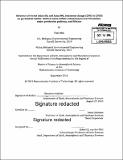Influence of recent Asian SO₂ and Asian NOx̳ emissions change (2001 to 2010) on particulate matter : shifts in Asian sulfate enhancement over US surface, major production pathway, and lifetime
Author(s)
Min, Flora
DownloadFull printable version (7.120Mb)
Other Contributors
Massachusetts Institute of Technology. Department of Earth, Atmospheric, and Planetary Sciences.
Advisor
Susan Solomon.
Terms of use
Metadata
Show full item recordAbstract
A 3-D chemical transport model with coupled oxidant-aerosol chemistry (GEOSChem) is used to analyze the influence of recent (2001 to 2010) growth in Asian NOx and Asian SO 2 emission on transpacific transport of Asian particulate matter, especially sulfate, by quantifying and analyzing the details of chemistry and its sequential influence on transpacific transport during spring and summer. From 2001 to 2010, the spring averaged Asian sulfate enhancement in the western US model surface layer increases by 0.01-0.03 [mu]g M-3 (about 4% of the surface sulfate concentration over the US at 2010 emission level). The net chemical production rate increases in the troposphere over Asia but decreases over the Pacific Ocean. The sulfate production pathway shifts toward gas phase production by OH (7-8% increase-China; 2-3% increase-Upper atmosphere Pacific Ocean) with corresponding reductions in aqueous phase production by H202 ; resulting in a switch of the most important production pathway from aqueous production by H202 to gas phase production by OH. Almost doubling the Asian NO. emission during the period has a negligible influence on Asian sulfate enhancement over the US; this change in Asian NOx emission causes the net chemical production rate to increase in the Asian boundary layer, but to decrease in the upper Asian atmosphere, and in the atmosphere over the Pacific Ocean and the US. This is because the Asian NOx emission growth strengthens the oxidizing power in the Asian boundary layer to more actively form sulfate (mostly removed by wet scavenging), reducing available SO2 for further production away from the source. The Asian NOx emission growth is the major driver in changing the sulfate production pathways toward the gas phase. The 20% increase in Asian SO 2 emission during the period is the primary driver in increasing Asian sulfate enhancement over the US; this change accelerates net sulfate production rate, and makes a minor contribution to shifting toward gas phase production by OH over the course of the transpacific transport. The calculated sulfate column burden shows a notable increase as a response to the changes in Asian emissions. However, the shifts in sulfate lifetime over China due to changes in Asian SO 2 and/or Asian NO, emission are almost negligible (generally 1-2%), and lifetimes over the upper level Pacific Ocean are generally reduced by 3-4%.
Description
Thesis: S.M. in Atmospheric Science, Massachusetts Institute of Technology, Department of Earth, Atmospheric, and Planetary Sciences, 2014. In title on title-page. double-underscored "x" appears as subscript. Cataloged from PDF version of thesis. Includes bibliographical references (pages 42-49).
Date issued
2014Department
Massachusetts Institute of Technology. Department of Earth, Atmospheric, and Planetary SciencesPublisher
Massachusetts Institute of Technology
Keywords
Earth, Atmospheric, and Planetary Sciences.